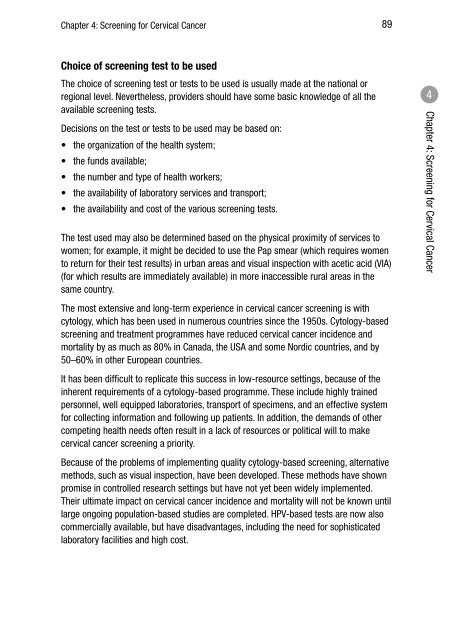CHAPTER 4: SCREENING FOR CERVICAL CANCER
CHAPTER 4: SCREENING FOR CERVICAL CANCER
CHAPTER 4: SCREENING FOR CERVICAL CANCER
Create successful ePaper yourself
Turn your PDF publications into a flip-book with our unique Google optimized e-Paper software.
Chapter 4: Screening for Cervical Cancer 89Choice of screening test to be usedThe choice of screening test or tests to be used is usually made at the national orregional level. Nevertheless, providers should have some basic knowledge of all theavailable screening tests.Decisions on the test or tests to be used may be based on:• the organization of the health system;• the funds available;• the number and type of health workers;• the availability of laboratory services and transport;• the availability and cost of the various screening tests.The test used may also be determined based on the physical proximity of services towomen; for example, it might be decided to use the Pap smear (which requires womento return for their test results) in urban areas and visual inspection with acetic acid (VIA)(for which results are immediately available) in more inaccessible rural areas in thesame country.The most extensive and long-term experience in cervical cancer screening is withcytology, which has been used in numerous countries since the 1950s. Cytology-basedscreening and treatment programmes have reduced cervical cancer incidence andmortality by as much as 80% in Canada, the USA and some Nordic countries, and by50–60% in other European countries.It has been difficult to replicate this success in low-resource settings, because of theinherent requirements of a cytology-based programme. These include highly trainedpersonnel, well equipped laboratories, transport of specimens, and an effective systemfor collecting information and following up patients. In addition, the demands of othercompeting health needs often result in a lack of resources or political will to makecervical cancer screening a priority.Because of the problems of implementing quality cytology-based screening, alternativemethods, such as visual inspection, have been developed. These methods have shownpromise in controlled research settings but have not yet been widely implemented.Their ultimate impact on cervical cancer incidence and mortality will not be known untillarge ongoing population-based studies are completed. HPV-based tests are now alsocommercially available, but have disadvantages, including the need for sophisticatedlaboratory facilities and high cost.4Chapter 4: Screening for Cervical Cancer
















